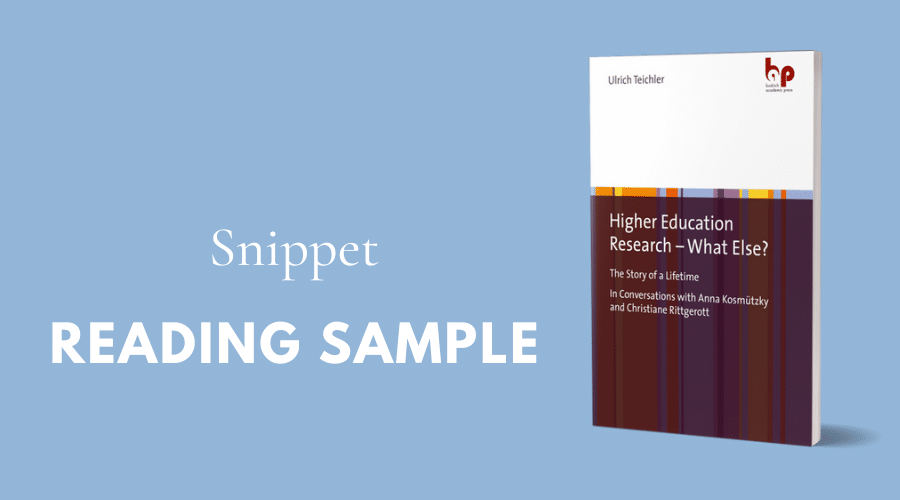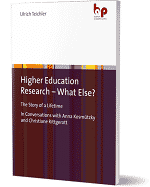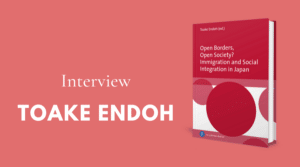18) Higher Education Research and Higher Education Practice: “To Hear the Grass Grow”
Publications have played an enormous role in your academic life, but they were only part of your discourse with your surroundings. How do you view the relationship between science and practice?
In the past, scholars in many fields had a clearly structured view about the production and dissemination of knowledge. A work process came to an end as a rule when one or a few texts emerged and were published in a more or less reputable way. Direct communication with others was in most cases limited to the presentation of research findings, possibly combined with a discussion, possibly presented at a conference, possibly already presented at interim stages, but certainly at the end. And this communication more often addressed other scholars than a wider audience. Some scholars wanted to get to know how the publications were perceived by the public – but the majority focused on the scientific world. For many years, book sales figures and numbers of reviews published were the most important sources of relevant information. Later on, the number of publications and of citations were added. Some scholars even believed that these data were ‘impact measures’ – this term shows more than anything else that the dispersion of knowledge among academics often is viewed as the highest aim.
When I learned how to ‘walk’ in academia, I was socialized to take such traditional views for granted. During my work as a professor of higher education research, however, I learned that I could not limit myself to traditional academic dissemination. I concluded that the results of higher education re-search will only be perceived widely if they are carried to the actors in the higher education system – often orally and often closely linked to their reflection of practice. Thus, I developed – step by step and not always strategically driven – a quite elaborate system of communication with the ‘world’ of higher education, i.e., the same ‘world’ as the focus of my analysis.
As already mentioned, I estimate that I spent half my working time ‘internally’ and the other half ‘externally’. Probably, it would be more appropriate to talk about four almost equal areas of work, even though I have not counted the number of hours: (1) activities directly part of or linked to research: writing project proposals, being involved in the project processes, and analyzing the findings; (2) other internal work related to my role as professor and chair of a research unit: teaching, management, reporting, etc.; (3) publishing the results and taking care of the conventional tasks of dissemination; (4) communication with other higher education researchers, academics in other fields and representatives of policy and practice for a variety of purposes ranging from dissemination of research results and communication about developments in higher education to reflections about new challenges for research and generating ideas for new research proposals.
How did it come about that communication with practitioners became so important for you?
As I already said, there was hardly any research on higher education in Germany about five decades ago. We tended to say, “the professor conducts re-search on everything except on the university – his or her own environment.” The reflection of those active in the university was viewed as sufficient, and no serious problems were perceived that could possibly call for systematic inquiry. Higher education research was not accepted a priori as a one of the typical areas of specialization in the humanities and social sciences, such as philosophy, but it had to challenge the prevailing notions and had to fight for acceptance. And it would not suffice just to identify relevant issues, to analyze them and to publish the results, but we had to carry this knowledge to the ac-tors.
Over the years I participated at hundreds of conferences and other events arranged by various organizations and addressing various target groups in the higher education system. This provided me the opportunity to present the state of knowledge regarding a specific topic and eventually to point out what this knowledge could mean for possible action. Of course, most of these events helped to broaden the horizon of the participants and led to a better understanding of the issues at stake. Beyond that, many people seemed to have come to the conclusion that it is not so bad if there is something like higher education research.
Of course, I did not consider these dialogues just as being helpful for others. They could be helpful for me as well, because my knowledge as a higher education researcher about the inner life of many features of higher education, notably those of the academic disciplines, is bound to be limited, and it was helpful for our research to observe how the actors in the higher education sys-tem reflect their own situation.
How successful were your efforts to reach the higher education public and the ‘reflective practitioners’?
As you know, I like to relate anecdotes in response to such a question. Very positive, but also very negative experiences cross my mind. My anecdotes might not be representative for most of the cases, but I also do not consider them to be completely exceptional.
In 1995, the Academia Europaea invited scholars and other actors from the higher education system to a conference held in Rotterdam on the academic profession. This provided me and my colleagues in the research team the opportunity to report about the typical ways that members of the academic profession think and act in various countries, as we had observed in the Carnegie study from 1992. After my presentation, a professor from the natural sciences raised his hand. He argued that everything that I had said was completely wrong, and he started telling stories about his daily life. I responded to him in about the following way: A short time ago, I woke up in the middle of the night, sweaty and haunted by self-doubt. I thought that I should not have chosen higher education research as my area of expertise. If I had chosen ‘mad-cow disease’ instead and if I had presented the results of my findings to the target group of my research, i.e., the mad cows or possibly the healthy cows, I would not have been criticized by them as being ignorant. But when I woke up the next morning, I felt happy again to have chosen higher education research. I thought, if I as an expert on ‘mad cow disease’ would have encountered some problems in interpreting the findings of my research and had asked my target group to help me, at most they would have said “moo”! In contrast, a higher education researcher analyzing the most intelligent professional group in the world would expect enormously interesting and intellectually challenging responses. For me as a higher education researcher, the only task that remains is to find out which interpretation is less appropriate and which one more. Later, I told this story at a conference of higher education researchers, and colleagues present there encouraged me to tell it again and again on other occasions.
There is another story. We had undertaken a comparative study on academic careers in the United States and in Germany. In 2006, I was asked by the network GAIN – established by major German academic organizations to maintain contact with young German academics who had moved to the US – to present the results of this study in Boston in front of an audience of about 300, primarily young Germans. When various German media interviewed me afterwards, the well-known weekly newspaper DIE ZEIT chose the title: ‘The Fairy Tale of the Scholars’ Paradise’. We had analyzed the likelihood that graduates and doctors stay in academia, the positions they attained, income, distribution by institutional rank, etc., in the US and Germany. We concluded that on average career opportunities in the US were altogether more or less equal to those in Germany, but were more varied according to institutional rank in the US. Therefore, the German doctoral candidates or post-docs going the US to famous universities were quite successful if they remained at these institutions. But since these few institutions trained the future academics for al-most three quarters of the overall system, most of the Germans in the US also had to expect to end up in a less impressive situation afterwards. In any event, a comparison of the entire national systems would be realistic. When I finished my talk in Boston, I experienced the angriest or at least the most skeptical re-action to any of my presentations in my whole life. I should not have been surprised to note that a mix of hope and uncertainty in the audience came into play. Yet, I was glad that at least a few young scholars came to me during the coffee break and expressed gratitude for this opportunity of gaining a realistic picture.
Our experiences were so varied that it is difficult to say whether positive reactions outweighed the negative ones. Of course, it was an encouraging experience for me that I had been involved in the research project on international student mobility that we undertook in close touch with the EU administrators preparing the establishment of the ERASMUS program. But I have to say that our influence on various features of the ERASMUS program could be strong because there was already a mood favoring a substantial increase in temporary student mobility at the time when we presented our findings.
Sometimes, I could observe an impact of my activities through other means than elaborate arguments. When the international ‘ranking’ fashion reached Germany, ten universities were selected in 2006 to receive privileged financial support in the framework of the so-called Excellence Initiative. On the day when the list of the ten winners was expected to be announced, I got a phone call early in the morning from a journalist at the German Press Agency. He asked me for a comment, even though the winners were not yet announced and even though I had no information in advance. Yet, I agreed to respond, “The next time around, good teaching has to be on the agenda!” On the following day, I noted long articles on the front pages of the major newspapers about the winners. But underneath each there was a small article, “The higher education researcher Teichler says ‘Teaching has to be on the agenda next time’.” During the subsequent two years, more prizes for good teaching were established in Germany than ever before or afterwards. I was happy to see that brief irony can be effective, but this is not the type of visible impact of higher education research I strive for.
I believe that I usually can expect an increasing willingness to reconsider as a consequence of communication between scholars and practitioners. An-other story: The social scientist, university president and active party politician Gesine Schwan introduced me to a group of university presidents with the words, “if you talk with him and tell him your views about academia and your managerial philosophy, he will present facts and figures to you within a minute that might look small and detailed at the beginning, but will turn out to be absolutely surprising and challenging for you to reconsider your views.”
I had come to the conclusion that higher education researchers’ investments of time and energy in communication with policymakers and practitioners are not in vain. Over the years, interest has grown to listen to our insights and findings and to discuss them with us. And we have seen a growing role of evaluation activities as well as a professionalization trend in the higher education system, which both improved opportunities for creative dialogues. There are trends towards more open dialogues – not only with us. For example, when evaluation activities began to spread, I often noted at the beginning that scholars serving as evaluators asked suggestive questions; one could note from the outset that they viewed possible response (a) as positive and possible response (b) as negative; in the meantime, however, evaluators seem to have become more professional, i.e., more open to unexpected information that might challenge their prior assumptions. Our dialogues with practitioners hopefully have contributed to their professionalization.
***
Would you like to read more?
Order via our webshop

 Higher Education Research – What Else?
Higher Education Research – What Else?